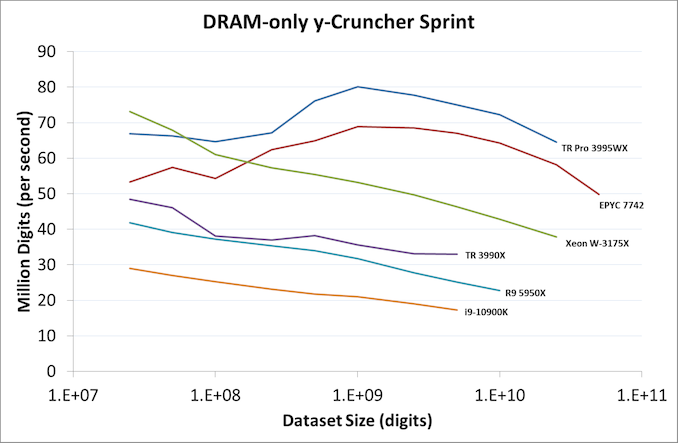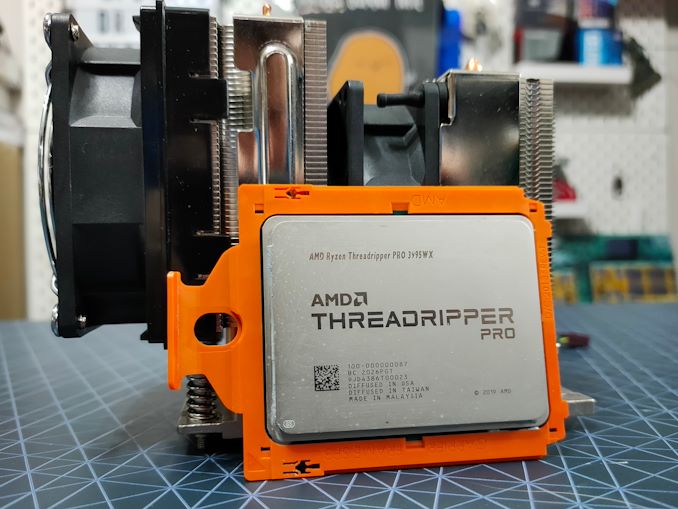Lenovo ThinkStation P620 Review: A Vehicle for Threadripper Pro
by Dr. Ian Cutress on February 16, 2021 9:30 AM ESTDo It For The Bits
With a review of an OEM system, it can be sometimes hard to separate the conclusion on the hardware from the system itself. Inside a laptop, it’s a lot easier, as the OEM can combine a number of things into a small chassis and optimize for performance – on the desktop and workstation side however, there’s usually not so much to budge on performance, although design, thermals, and acoustics all come into play. The review has to end up focusing a lot on the value, performance per dollar, and build quality, and any extra bells and whistles. Luckily for Lenovo ThinkStation P620, the focus isn’t so much on the price, but all those bells and whistles.
The ThinkStation P620 system that Lenovo sent us was the company’s first ever AMD ThinkStation platform. It was set up with the top end AMD Threadripper Pro 64-core processor, a beefy NVIDIA RTX 6000 GPU, and some solid storage. Taking advantage of the platform, Lenovo put 80 lanes worth of PCIe connectivity in out of the 128 offered by the processor, as well as 512 GB of memory support through eight memory channels. The fact that Lenovo only sent a review unit with two memory sticks is an unfortunate $200-$400 saving on a $20000 review sample and really hurts the performance in some of the tests on the CPU, but to see the full 8-channel results, head on over to our dedicated CPU review. Memory aside, Lenovo has a lot going on in this system worth talking about.
A lot of off-the-shelf systems take standard PC parts and put them together. The size and skill of a company like Lenovo means that they don’t have to do that, and we get designs like the P620. Lenovo has a fully custom motherboard just for this product line, and it uses an ultra-special power supply that has zero power output cables. Lenovo has designed the system such that the PSU plugs into the motherboard like a standard connector, and all 1000 W goes to the rest of the system through the motherboard rather than cables. This means the motherboard has to be designed to take care of all that power, but it reduces the overall size of the system without the need to route cables (the whole design is 33.4 liters, rather than 70+ for a modern high-end PC), and makes the power supply so easy to remove, upgrade, replace, and all that. It is very obvious how deep the design goes here.
On to that, the system also has a PCIe bracket area that is both tool-less and easy to use, and the PCIe card is fixed in with an external stiffener which effortlessly blends in with the rest of the system. The two M.2 slots are built into the motherboard and perhaps more difficult to access, with our system having one of them populated with a 512 GB WD SN530 drive. There are also four 3.5-inch bays for dedicated storage in the bottom of the chassis. Two of the PCIe slots are also aimed at storage add-ins, such as the M.2 riser cards now available.
Lenovo lavishes on the USB 3.2 Gen 2 (10 Gbps) support with eight ports total, four on the front panel, and two of those being Type-C. Networking is through a copper 10 gigabit connection, with options for more advanced connectivity through the PCIe slots. To help out with debugging, there’s a four-digit display on the front panel that turns off after a successful boot.
Another nod on design here – the CPU cooler uses a differential height dual tower design, and the full retail system is designed to have an air baffle between the top and bottom areas, enabling for cooling zones. Cooling on this system is really nice, with the lowest fan setting and a sustained 24-hour CPU+GPU load putting the CPU at 78ºC and GPU at 81ºC. The system was warm to touch on the top, but nothing out of the ordinary. The full system power draw, with the 64-core AMD and RTX 6000, came to 640 W.
For the processor, performance on AMD’s Threadripper Pro 3995WX was a few percent higher than the standard Threadripper 3990X in our testing, with the eight channels of memory offsetting the slightly lower CPU frequencies. Our system observed 4200 MHz on single core turbo, 4000 MHz when up to 20 cores are active, and a sliding scale down to 3100 MHz on all cores when at full tilt. The +3% performance uplift isn’t enough to change the +$1500 list price of the processor, because ultimately that extra cost is going into the features, such as more PCIe 4.0 lanes, higher memory capacity, and professional-grade system administration through a Pro platform, most of which the ThinkStation P620 enables, along with a stellar chassis design.

Benchmark from our 3995WX CPU Review, showing 8 Channel Performance
It’s hard to judge a system without a price, but we have to ignore the prices on Lenovo’s website – the company has told me in the past that less than 5% of workstation sales happen like that, and the website only limits a user to five units. Most ThinkStation P620 sales happen through the B2B channels, where a visual effects company orders a few dozen for its artists and designers, perhaps gets a discount, but also enables Lenovo’s pro service and warranty packages. This usually includes replacement machines if one needs to be returned and things like that.
Take this recent Linkedin post from a product manager at Lenovo, showcasing another visual effects design studio that purchased a dozen 64-core variants of the Thinkstation P620 after some initial testing.
At this time Lenovo has the exclusive on Threadripper Pro, and so the P620 is the only option in the market. It’s a really nice option, and for those that need it, it surely fits the bill. There are going to be a number of OEMs coming out later this year with their own TR Pro systems when the exclusivity expires, but they will mostly be using off-the-shelf motherboards. Lenovo’s design is unique, and has hallmarks of design ideas I’d love to see in the industry at large. I don’t see much going wrong for a user that has to use one of these systems. Just make sure it’s got eight memory sticks. Please. Do it for the bits.














47 Comments
View All Comments
GeoffreyA - Tuesday, February 16, 2021 - link
"If all PCs were like this, the world would be a brighter place."Indeed, feel the same way too. Sheer excellence for once.
pattiobear - Tuesday, March 2, 2021 - link
More engineering and thoughtful design? Sure.Proprietary/nonstandardized parts and connections? Not as much.
willis936 - Tuesday, February 16, 2021 - link
That’s a nice looking machine and is fairly priced. My only concern is the use of small, high power fans for cooling. It makes sense in rack mounted situations, but this is a large workstation with lots of free space. They should stretch their legs with larger heatsinks or water cooling.Also, in the conclusion:
“ On to that, the system also has a PCIe bracket area that is both tool-less and easy two use”
Unless this is a pun I missed, this should be “to” not “two”.
DanNeely - Tuesday, February 16, 2021 - link
the case/CPU fans look like full size ones. And while the memory fans are only 40mm, the amount of airflow needed to cool the ram should be low enough that a quiet fan should be sufficient; no need for the eleventeen zillion RPM ones to push >100W each in 1U chassis. The 46db Ian measured at load fits with quiet fans not screamers; if the ram fans were driving the noise profile I would have expected him to say something because they'd have a very different sound than bigger fans do when speeding up.andychow - Tuesday, February 16, 2021 - link
If they are offering a 42% discount on a new system, you know they are screwing you over if you ever pay retail.This is an 8 channel memory system, comes base with 1 stick? They shipped it with 2 sticks? Rather strange marketing descision.
Spunjji - Wednesday, February 17, 2021 - link
"you know they are screwing you over if you ever pay retail"That's just it - nobody ever pays the quoted prices on these things. The question is whether you get the "discount" that's for everybody or the one that's for special customers.
stevielee - Tuesday, February 16, 2021 - link
Noticed that just behind the bars of Memory is a photo of Rick Astley from his early "Never Gonna Give You Up" days. Could there be a 'hidden' review meaning about this Lenovo Thinkstation P620? As in being "Rick Rolled" if you buy into the whole kahuna?WaltC - Tuesday, February 16, 2021 - link
Nice review, Ian...;) All I can say looking at those options is a person could do much better just starting with the motherboard and putting the system together himself with his own component choices! Reducing an 8-channel capability to dual channel ROOB is a big blooper--should at least be supplying 4 channels with 4x8GB, imo. The motherboard is PCIe4, isn't it? Odd to see the NVMe's restricted to PCIe3. Leaving a boatload of performance on the table, looks like.WaltC - Tuesday, February 16, 2021 - link
Meant to say 4x16GB...8GB, even 4-channeled, really isn't even a minimum...;)TomWomack - Tuesday, February 16, 2021 - link
I am a bit wary of the 'power supply can easily be replaced' line - it is a very custom power supply, if Lenovo stop making them you're screwed, and it's much more likely that Lenovo would stop making this specific thing than that ATX power supplies become unavailable.In my experience power supplies are very much the first thing to fail, which is why I'm concerned about this - I've taken to buying second-hand dual-PSU servers and keeping one PSU aside so that I have one spare per system.